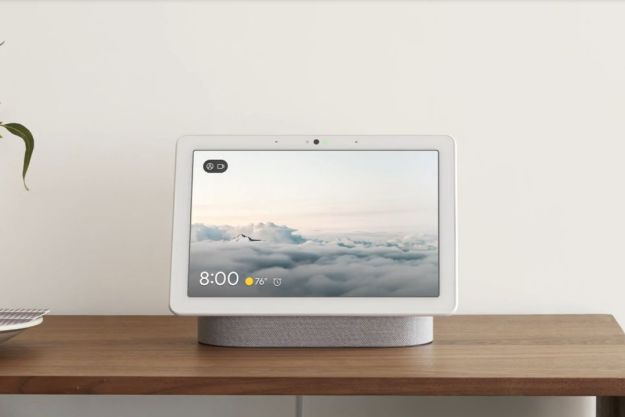When it comes to the best smart displays, the new Facebook Portal and the Google Nest Hub Max are two great choices. These 10-inch smart displays may look very different, but they both have a lot of great features, like awesome display quality and great sound. This can make choosing the right one for you difficult. To help, we’ve pitted the two against each other in a head-to-head battle to find out which one is the better pick.
Design

When it comes to aesthetics, these two displays couldn’t be more different. The Nest Hub Max has graceful lines and a floating display design that looks modern and fresh. The Portal, well, it looks like a cheap picture frame you could get at a dollar store, which is strange since its predecessors had a much more upscale style. They both come in two colors, though.
Winner: Nest Hub Max
Camera
 Facebook Portal 10-inch 2019 AR" width="720" height="480" />
Facebook Portal 10-inch 2019 AR" width="720" height="480" />How you look when you’re on a video call is important, right? So a good camera is crucial. Nest Hub Max sports a 6.5-megapixel camera while the Portal has a 13-megapixel camera. This means the Portal’s camera will be able to capture much more detail than the Hub Max. Both cameras will follow you as you walk around a room, but the Max has a substantially wider field of view at 127 degrees when compared to Portal’s 114-degree field of view.
If you’re not worried about how far the camera can follow you or how many people you can fit into a video call, then the field of view won’t matter much. Plus, when you’re on calls using the Portal you can add cool AR effects and filters. You can also tell animated stories using the Story Time feature.
Winner: Portal
Display
One of the biggest features to look for when buying a smart display is, of course, screen quality. Both of these displays really knocked it out of the park on this design feature. Both have adaptive displays that adjust to match the lighting in the room. This makes anything on the screen look extra crisp and clear with true-to-life colors.
Winner: Tie
Audio
Neither of these displays has the best audio on the market (that’s better left to smart speakers), but they’re pretty solid when it comes to bass quality and clear, rich sound that can fill a room. They both seem to lose quality as the volume is increased towards the higher ranges, though. Unless you’re a picky audiophile, you’ll probably be pretty pleased with either display. Bass lovers will gravitate towards the deeper tones of Portal, while tuning the bass and treble with the Nest Hub Max can make it more balanced in tone.
Winner: Tie
Functionality
There’s no contest when it comes to functionality. Nest Hub Max is just so darn useful. The coolest feature is that the Max can recognize your face, then bring up content on the screen that is tailored just for you and can save up to six different face profiles. You can also pause and play video or music with the wave of a hand. Plus, it has a Nest Cam built-in so you can watch over your home no matter where you are using the app. We like that it’s easier to watch videos on the Max and that you can see your to-do lists and calendar on the screen, too.

Meanwhile, Portal largely centers around the best experiences with Facebook — so think
Winner: Nest Hub Max
Price
There’s a big difference in price that just may sway you one way or the other. The Portal comes in at $179, but sales have it down to as low as $129 in an attempt to sway potential adopters. Google’s Nest Hub Max commands a price of $229, a hefty initial investment, but one that comes with additional functionality and experiences.
Winner: Portal
Which should you buy?
Facebook Portal and the Google Nest Hub Max are pretty well matched in most areas. Probably the biggest difference between these two smart displays is that they are firmly Team
The same goes for the Nest Hub Max. This display sources photos through your Google Photos account and makes calls using contacts saved to your Google account. It also uses Google Assistant for voice commands. So, if you’re not a Google user, and don’t plan on becoming one, the Nest Hub Max probably isn’t a good choice.
If you have a favorite team, the choice is easy. If not, Portal is the much more affordable choice and has a fantastic camera. The built-in Alexa allows you to control your
Our favorite, though, is the Google Nest Hub Max. It has so many useful functions and features, it really just can’t be beat. In fact, it won as our choice for the best smart displays for 2019.
Editors' Recommendations
- Blink Mini 2 vs. Nest Cam (Indoor): Which is the better affordable security camera?
- Echo Hub vs. Echo Show 15: Which is the best smart home gadget?
- Echo Hub vs. Echo Show 8: Which is the best option for your smart home?
- The 6 best smart displays for Alexa and Google Home in 2024
- Echo Show 8 vs. Nest Hub: Does Amazon or Google offer the best smart display?






